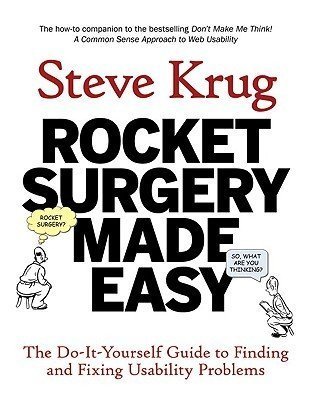Rocket Surgery Made Easy: The Do-It-Yourself Guide to Finding and Fixing Usability Problems by Steve Krug
My rating: 3 of 5 stars
An easy-to-read guide to doing your own inexpensive usability testing. I liked Krug’s humorous writing and entertaining use of quotations, and the book's cartoons make it even easier to understand. I didn't find it as informative as Krug’s previous book, Don’t Make Me Think.
Krug says that DIY usability testing is inferior to hiring a usability consultant, but it’s better than not testing. He says that if you can afford to, you should hire a usability professional.
Krug summarizes his approach as follows:
Basically, the facilitator sits in a room with the participant, gives him some tasks to do, and asks him to think out loud while he does them. There's no data gathering involved. Instead, members of the development team, stakeholders, and any other interested parties observe the session from another room, using screen sharing software. After the tests are finished, the observers have a debriefing session where they compare notes and decide what problems should be fixed and how to fix them.
I read this because we do informal user testing at OptimWise, and I want to improve our process.
Finding Usability Problems
- Analytics can tell what people do, but not why. Usability testing tells you why.
- Krug's usability demo video
- A typical test takes one hour.
- The point is to identify major problems and fix them. Most kinds of problems that need to be fixed are so obvious that you don't need many testers.
- Start testing as early as possible.
- Before creating your own site, test similar sites to learn from their positives and negatives.
- "A morning a month" plan: One round of testing monthly (on a regular schedule). Do three tests in the morning, then debrief over lunch. Fix problems before the next round.
- Try to get users who reflect your audience, but you can learn from testing with practically anyone.
- Don't use testers in more than one round of testing. After one round, they know too much to be effective.
- Create tasks (things you wanted to do), then expand them into scenarios (brief scripts with needed context and details).
Fixing Usability Problems
- Focus on fixing the most serious problems first (determined by how many people will experience a problem and how severe it will be for those who experience it).
- "When fixing problems, try to do the least you can do." Make it better for users right now. Don't bother with "doing it right." Techniques: tweak, don't redesign; take something distracting away.
The Road Ahead
- Remote testing gives about 80% of the benefits of live testing with about 70% of the effort.
- Lower-cost company, lower-quality option: unmoderated remote testing like usertesting.com.
